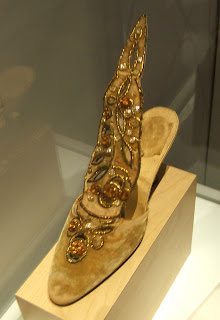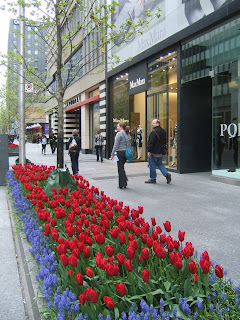the charming Sonja Bata wore a beautiful light coral suit and the discrete Order of Canada decoration on the night of the exhibition opening
Roger Vivier's salon, circa 1990; note the 18th century room rendered modern and less formal with terra cotta tile floor, absence of curtains, and a lack of moldings; it retains a whisper of the 18th century with the aristocratic room proportions, mullioned windows, a few choice antiques, and a very balanced arrangement of furniture, from Roger Vivier by Pierre Provoyeur, Éditions du Regard, 1991

a pair Louis XV chinoiserie red lacquer cabinets lend balance on the sofa wall; opposite the low table is a pair of black leather Mies designed Barcelona chairs, from Roger Vivier by Pierre Provoyeur, Éditions du Regard, 1991
The opening night reception of this exhibition was very elegant and enjoyable. The fashionistas were in full force. Socialites Catherine Nugent, Westons, and devoted fashion animal Suzanne Rogers were present. Grande dame Sonja Bata spoke with great charm at the introduction and related the designs of Dior and Vivier to the late 1940s when she was a young bride (she was married in 1946, the year before Dior’s revolutionary “New Look”), and how joyful and fresh they appeared in contrast to the broad shouldered utility wear of the war years. She also mentioned that, “The shoes weren’t that comfortable,” which brought unanimous laughter from the audience. French consulate representatives, prominent journalists Jeanne Beker, Bernadette Morra, and David Livingstone also attended. Museum curator Elizabeth Semmelhack spoke of the genius of Roger Vivier and was on hand to answer questions and sign copies of her excellent book on the designer. Guests listened to a French style chanteuse with piano accompaniment and Moët & Chandon flowed very freely.
The party was so much fun that it was difficult to tear one’s self away to view the spectacular shoes. I did look at them with great interest, but will have to revisit to contemplate their amazing design without the party crowd. This is not a show just for admirers of fashion, because these shoes, especially some of the more fantastic, are great works of art in themselves, as much to be admired as objets, as to be worn. An interesting anecdote was told regarding some of the fantastic, embroidered and beaded masterpieces. A woman returned with one that lost some of the applied jewels and Vivier’s manager, Michel Brodsky responded, “But Madam, you wore them!”
This shoe will be running for the next eleven months, and is most highly recommended, as is a visit to the Bata Shoe Museum at any time. The Bata Museum is most conveniently located, steps from the St. George subway station and University of Toronto campus.
Portrait of Roger Vivier, 1990, from Roger Vivier by Pierre Provoyeur, Éditions du Regard, 1991
Roger Vivier paper collage, 1991, Bata Museum
bottine in style of Madame de Pompadour, blue silk satin, ribbon, lace, and sequins, 1961, Metropolitan Museum of Art
a showstopper in the exhibition was this pink satin sandal; it deserves to be put into production; with embroidered butterfly ornament, a 1953 sample, collection of the Bata Museum
early 1960s stilletto pump, covered entirely with iridescent feathers...a conservator's (and conservationist's) nightmare
these 1964 gold velour mules feature a very elongated tongue; because it was so visually dramatic, Vivier was frequently photographed with it; collection of Maison Vivier
a unique pump of pink fur (not sure if it is mohair or Orlon) with paste jewel and a unique Vivier heel, 1962-1963, Metropolitan Museum of Art
pink silk satin with paste jewel ornamentation, early 1960s
silk satin with silver embroidery and pearl pendant drops, 1959, Metropolitan Museum of Art
gold frame from the museum exhibition, done as a silhouette of a Louis XVI Dior salon frame with a bow at the top
detail of Roger Vivier's own penny loafers and Argyle socks, from the above portrait
the author's own loafers which he wore to this exhibition opening; I'll consider it my 'umble hommage to the master
gold satin pumps with gathered detail at the instep; these were bespoke, using same material as the dress they were worn with, for Princess Lilian of Belgium, circa 1953-1955
a departure from the 1950s are these mid 1965 pyschedelic print Pilgrim pumps with matching handbag
vivid printed silk pumps with one of Vivier's unconventional and very original polchinelle heels which lend the wearer a stylishly exotic air, 1961
silver leather high top sandal, with African mask-like ornament, likely contemporary with Yves Saint Laurent's tribal collection of 1966; I am reminded of the tin man in The Wizard of Oz
these exceptional pumps had a faintly Persian and 18th century look; certainly these are worthy of display in a vitrine; Marie-Hélène de Rothschild sometimes wore such dramatic shoes to her fantastic parties of the 1960s and 1970s; the donor of these shoes, society event and interior designer Valerian Rybar, was a good friend and collaborator with the famed Rothschild matriarch; 1962, collection of the Metropolitan Museum of Art
the conventional black pump is updated and becomes unexpected, and slightly perverse with sides of transparent vinyl; peek-a-boo was a style statement in the mood of being anti-establishment in the 1960s

this magazine advertisement represents a collaboration of three creative geniuses of design; shoe design by Roger Vivier to accompany the fashions of Christian Dior, depicted in this illustration by René Gruau, in which a delicately shod foot steps on a rose, all within the Louis XVI frame favoured in the couture salon and boutiques of Christian Dior

Vivier mule with an Indo-Persian feeling, embroidered with pearls and embellished with a wired, tiara-like ornament on the instep, 1959, Metropolitan Museum of Art
unless credit is specified, photos by Square With Flair
































